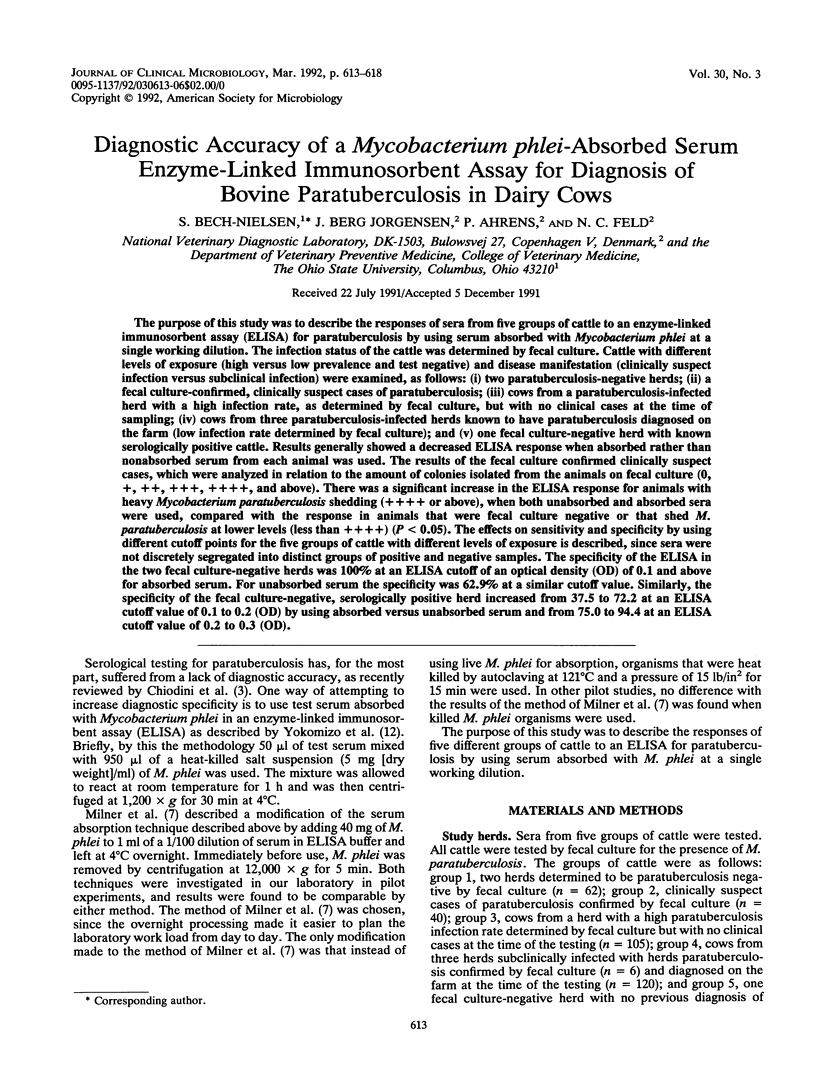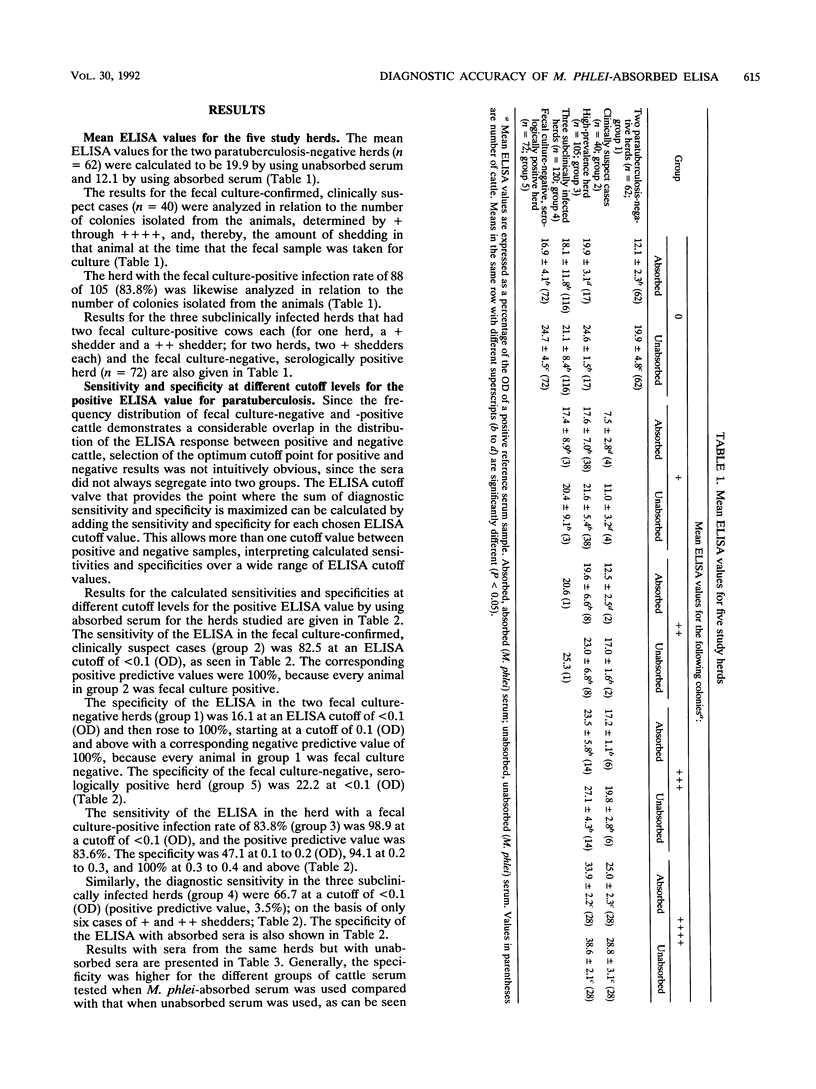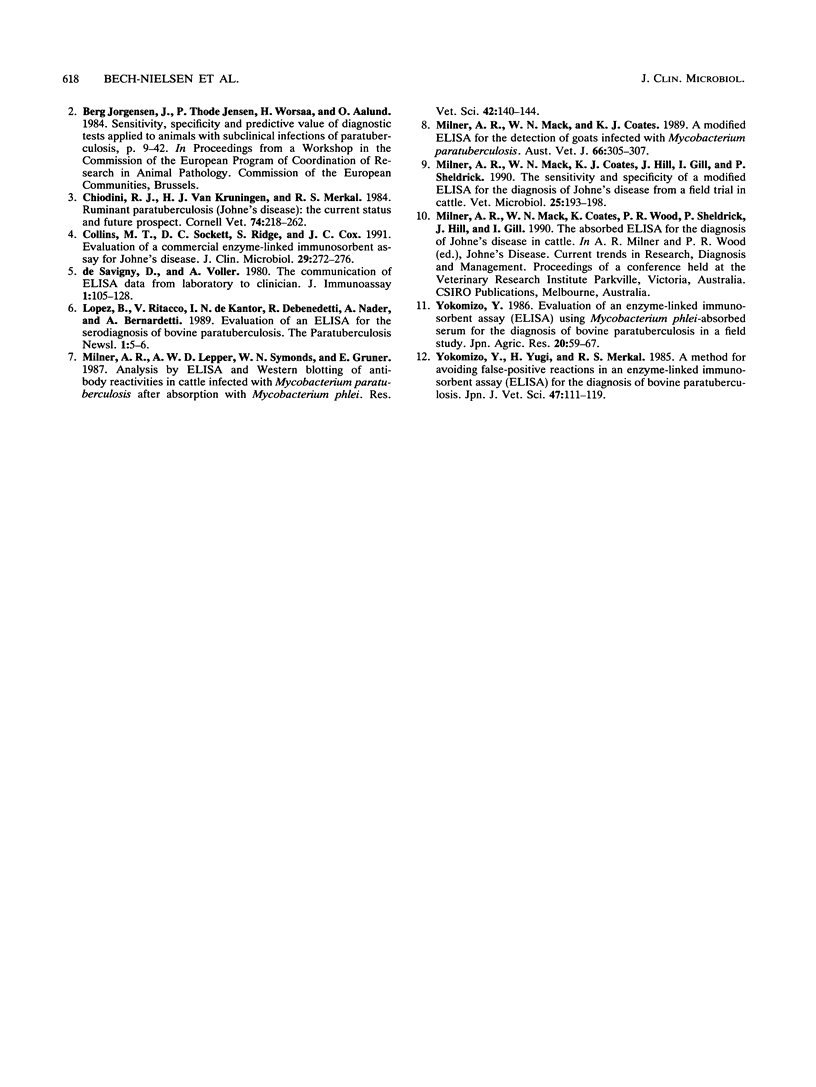Abstract
The purpose of this study was to describe the responses of sera from five groups of cattle to an enzyme-linked immunosorbent assay (ELISA) for paratuberculosis by using serum absorbed with Mycobacterium phlei at a single working dilution. The infection status of the cattle was determined by fecal culture. Cattle with different levels of exposure (high versus low prevalence and test negative) and disease manifestation (clinically suspect infection versus subclinical infection) were examined, as follows: (i) two paratuberculosis-negative herds; (ii) a fecal culture-confirmed, clinically suspect cases of paratuberculosis; (iii) cows from a paratuberculosis-infected herd with a high infection rate, as determined by fecal culture, but with no clinical cases at the time of sampling; (iv) cows from three paratuberculosis-infected herds known to have paratuberculosis diagnosed on the farm (low infection rate determined by fecal culture); and (v) one fecal culture-negative herd with known serologically positive cattle. Results generally showed a decreased ELISA response when absorbed rather than nonabsorbed serum from each animal was used. The results of the fecal culture confirmed clinically suspect cases, which were analyzed in relation to the amount of colonies isolated from the animals on fecal culture (0, +, ++,+++ , ++++, and above). There was a significant increase in the ELISA response for animals with heavy Mycobacterium paratuberculosis shedding ( ++++ or above), when both unabsorbed and absorbed sera were used, compared with the response in animals that were fecal culture negative or that shed M. paratuberculosis at lower levels (less than +) (P less than 0.05). The effects on sensitivity and specificity by using different cutoff points for the five groups of cattle with different levels of exposure is described, since sera were not discretely segregated into distinct groups of positive and negative samples. The specificity of the ELISA in the two fecal culture-negative herds was 100% at an ELISA cutoff of an optical density (OD) of 0.1 and above for absorbed serum. For unabsorbed serum the specificity was 62.9% at a similar cutoff value. Similarly, the specificity of the fecal culture-negative, serologically positive herd increased from 37.5 to 72.2 at an ELISA cutoff value of 0.1 to 0.2 (OD) by using absorbed versus unabsorbed serum from 75.0 to 94.4 at an ELISA cutoff value of 0.2 to 0.3 (OD).
Full text
PDF





Selected References
These references are in PubMed. This may not be the complete list of references from this article.
- Chiodini R. J., Van Kruiningen H. J., Merkal R. S. Ruminant paratuberculosis (Johne's disease): the current status and future prospects. Cornell Vet. 1984 Jul;74(3):218–262. [PubMed] [Google Scholar]
- Collins M. T., Sockett D. C., Ridge S., Cox J. C. Evaluation of a commercial enzyme-linked immunosorbent assay for Johne's disease. J Clin Microbiol. 1991 Feb;29(2):272–276. doi: 10.1128/jcm.29.2.272-276.1991. [DOI] [PMC free article] [PubMed] [Google Scholar]
- Jørgensen J. B. An improved medium for culture of Mycobacterium paratuberculosis from bovine faeces. Acta Vet Scand. 1982;23(3):325–335. doi: 10.1186/BF03546784. [DOI] [PMC free article] [PubMed] [Google Scholar]
- Milner A. R., Lepper A. W., Symonds W. N., Gruner E. Analysis by ELISA and Western blotting of antibody reactivities in cattle infected with Mycobacterium paratuberculosis after absorption of serum with M phlei. Res Vet Sci. 1987 Mar;42(2):140–144. [PubMed] [Google Scholar]
- Milner A. R., Mack W. N., Coates K. J. A modified ELISA for the detection of goats infected with Mycobacterium paratuberculosis. Aust Vet J. 1989 Sep;66(9):305–307. doi: 10.1111/j.1751-0813.1989.tb13963.x. [DOI] [PubMed] [Google Scholar]
- Milner A. R., Mack W. N., Coates K. J., Hill J., Gill I., Sheldrick P. The sensitivity and specificity of a modified ELISA for the diagnosis of Johne's disease from a field trial in cattle. Vet Microbiol. 1990 Nov;25(2-3):193–198. doi: 10.1016/0378-1135(90)90076-8. [DOI] [PubMed] [Google Scholar]
- Yokomizo Y., Yugi H., Merkal R. S. A method for avoiding false-positive reactions in an enzyme-linked immunosorbent assay (ELISA) for the diagnosis of bovine paratuberculosis. Nihon Juigaku Zasshi. 1985 Feb;47(1):111–119. doi: 10.1292/jvms1939.47.111. [DOI] [PubMed] [Google Scholar]
- de Savigny D., Voller A. The communication of ELISA data from laboratory to clinician. J Immunoassay. 1980;1(1):105–128. doi: 10.1080/01971528008055779. [DOI] [PubMed] [Google Scholar]


